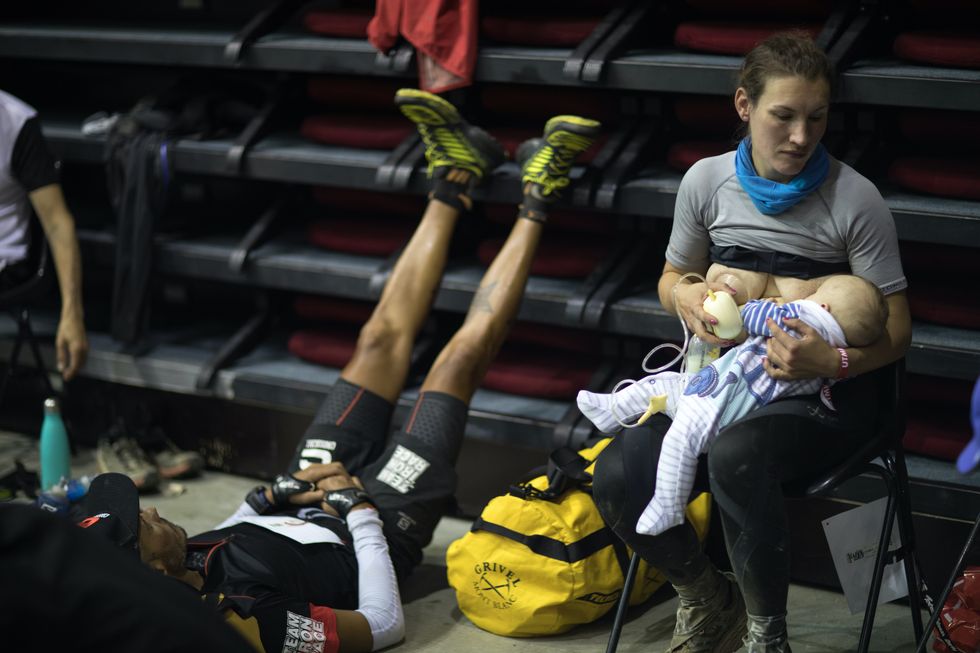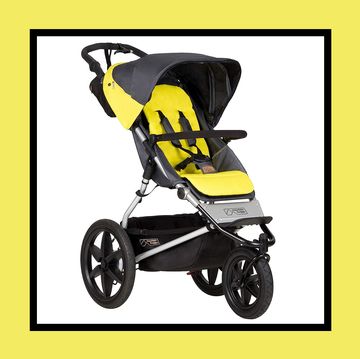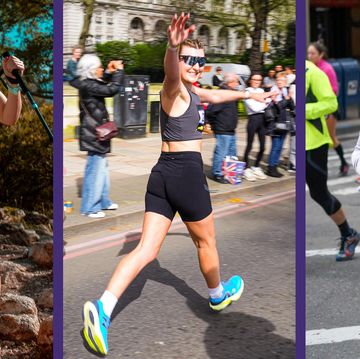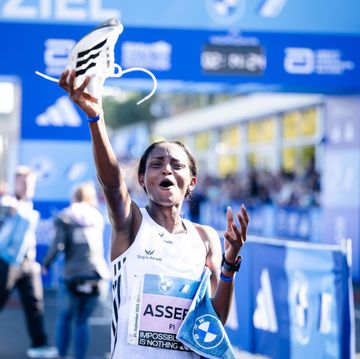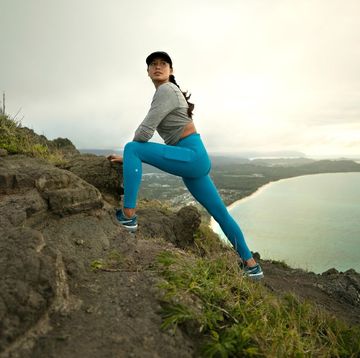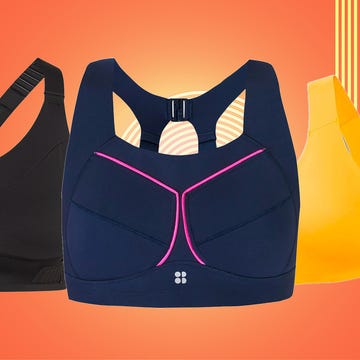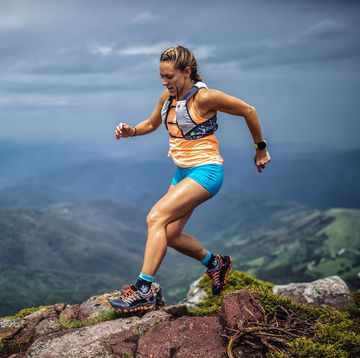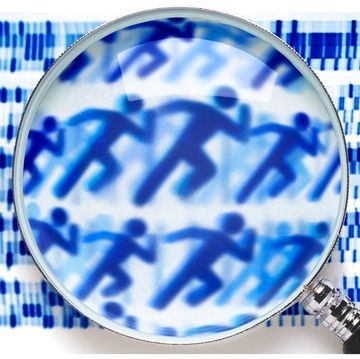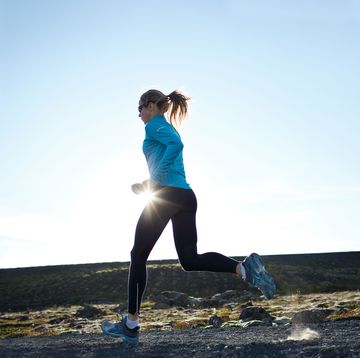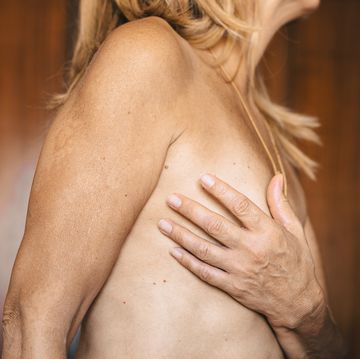For a long time, there was a startling lack of evidence-based guidelines on pregnancy and exercise. Incredibly, the first official UK guidelines weren’t issued until 2017, and advice on exercising postpartum wasn’t included until 2019.
The full document highlights that physical activity doesn’t negatively impact breastfeeding postpartum. However, female runners are likely to have many more questions about running and breastfeeding: can it affect your milk supply? When should you feed/express? What bras are best? Does it make you more susceptible to injury?
Running during pregnancy
In recent years, research has highlighted that it’s not just safe to exercise during pregnancy – it's beneficial.
For example, a 2022 paper published in the Journal of Perinatal Medicine, which reviewed 57 studies on pregnancy and exercise, found that exercise can help to prevent pregnancy-related disorders such as gestational diabetes, hypertensive disorders and urinary incontinence.
The NHS recommends that women keep up their normal daily physical activity or exercise for as long as they feel comfortable – highlighting that the more active and fit a woman is during her pregnancy, the easier it will be for her to adapt to her changing shape and weight gain.
However, it doesn't recommend that women suddenly take up strenuous exercise, such as running, if she wasn't active before her pregnancy.
It's worth noting that experiences of pregnancy, delivery and recovery are incredibly individual, so listening to your body and adapting accordingly is key. You can find out more by reading our comprehensive guide to running and pregnancy.
When is it safe to start running after childbirth?
While running is encouraged during pregnancy, returning to running postpartum should be approached cautiously, and you should seek advice and clearance from medical professionals.
'Pregnancy is an athletic event,' says certified obstetrician and mother-of-three Dr Lori Wendricks House, MD, FACOG. 'Not only was this your longest marathon – eight months of your heart, kidneys and lungs working harder than baseline, and the insult of passing a large object through your pelvis – the relaxin hormone that allows your skin to stretch also affects your joints, ligaments, muscles and spine. It will take time for all that to be back in running shape,' she adds.
Tissue healing can take four to six months, and women may experience pelvic floor dysfunction, such as incontinence or vaginal prolapse, abdominal weaknesses and lumbo-pelvic pain. Indeed, a 2018 review exploring urinary incontinence in female athletes found that high-impact exercise, like running, can increase the risk of pelvic floor dysfunction by 4.59 times, compared with low-impact exercise.
Dr Jane Simpson, a sport, exercise and musculoskeletal medicine consultant at Pure Sports Medicine, says running wouldn't usually be recommended until at least 12 weeks postpartum. 'It’s important to stress that this is very individualised and depends on a variety of factors, such as the mode of delivery – vaginal birth or caesarean – the grade of tears and medical conditions.’
A study published in Clinical Medical Insights: Women's Health found 12 weeks to be the median time for a mother's first postpartum run. However, 26% of women didn’t return to running at all and, of those who did, 84% experienced musculoskeletal pain and 29% experienced running-related stress urinary incontinence.
GB ultrarunner, founder of SheRACES and mother-of-three Sophie Power is very familiar with how unique pregnancies can be. Power was famously photographed breastfeeding her three-month-old son during the 106-mile UTMB by Alexis Berg, having been unable to defer her place.
Following her first pregnancy, however, Power says it was a real struggle to get back to running due to a difficult delivery, episiotomy and a damaged pelvic floor. So, she is keen to stress that running an ultra three months postpartum while breastfeeding is not very normal.
The widely celebrated image kickstarted conversations in the running world and beyond, and has since led to races introducing changes globally – including UTMB’s introduction of pregnancy deferrals – thanks to tireless campaigning by Power and others. 'People often ask me, "Do you wish you'd had a pregnancy deferral for that race?" And I guess, knowing the impact the photo has had, I'm glad I didn't because I think it's driven so much positive change.'
Is it safe to run while breastfeeding?
So, you’ve got the physiological green light to return to running, and you feel ready. But how does breastfeeding factor into all this?
A qualitative study with elite distance runners recognised breastfeeding as a barrier to training and competition, identifying limited access to relevant breastfeeding information and concerns for the baby’s health – for example, lactic acid in milk.
Dr Kate Hutchings is the clinical lead for the UK Sports Institute’s Female Athlete Health and Performance service and is part of the HQ Medical Team for Team GB at the Paris 2024 Olympic Games. Running while breastfeeding, she assures, is absolutely safe. 'Obviously, the breasts are producing milk, so your breasts get larger, and that can cause discomfort,' she says, because breast tissue is more sensitive – but it’s still safe.
To avoid discomfort caused by engorgement, Hutchings recommends expressing or feeding just before training – although it will depend on a mother's individual comfort and feeding times. 'As you exercise, you build up lactic acid in the system, which can be produced in the breast milk, so we tend to advise women to either express or breastfeed before training and run directly afterwards.'
However, this doesn’t mean that your milk isn’t safe. 'Babies may be less interested due to taste, but it is safe for the baby,' says Wendricks House. A 2020 study published in Breastfeeding Medicine analysed breast milk samples from mothers one hour before and one hour after moderate-to-high-intensity physical activity. Researchers found that this affected neither macronutrients – fat, carbohydrates and protein – nor energy content.
Wendricks House does warn, however, that due to prominent hormones during breastfeeding, you may feel a little sleepy after a run – making the prospect of a nap a little more inviting than a post-run feed. The prominent hormones during breastfeeding are prolactin and oxytocin. 'Prolactin helps with milk production and makes one feel calm, relaxed and sleepy,' explains Wendricks House. 'Oxytocin supports milk ejection and causes similar feelings of attachment and wellbeing.'
Are you susceptible to injury while breastfeeding?
Aisling Freir, a pelvic health and musculoskeletal physiotherapist at Pure Sports Medicine, highlights that your oestrogen levels will be lower while breastfeeding. 'These lower levels of oestrogen can lead to dehydration of tissues in the vaginal area and increased risk factors for bone stress injuries, which we are aware is much higher in the post-natal population in general.'
However, research is mixed and more is needed. A 2022 clinical paper published in the Journal of Women’s & Pelvic Health Physical Therapy noted that individual differences in how breastfeeding hormones alter bodily tissues mean reports on how connective tissue, joint laxity and tendons are affected are conflicting.
Freir points to research published in the British Journal of Sports Medicine last month, which surveyed clinical and exercise professionals working with postpartum runners. It highlighted a prevalence of injury and/or pain in postpartum runners, reinforcing the need for gradual training progression.
Tips for breastfeeding runners
Hydration
Running itself won’t affect your milk supply, says Emily Butterworth, an NHS midwife, certified IBCLC breastfeeding specialist and midwife for breastfeeding platform Lansinoh – but dehydration can reduce it. If dehydrated, your breasts may also become engorged because your body holds onto fluids to prevent further dehydration, she explains.
To prevent this from happening, make sure you're sipping on fluids regularly throughout the day and rehydrating within the first hour after finishing a run.
Your can gauge your hydration levels by thirst, but also by the colour of your urine. If you’ve generally got a pale, straw coloured urine throughout the day, then that’s a pretty good indicator that you’re sufficiently hydrated.
Fuelling
Butterworth highlights the importance of replenishing the calories burnt through running if you are breastfeeding, since your calorie demands will already be greater. 'The amount of calories you burn while breastfeeding will depend on your diet, level of physical activity and weight pre-pregnancy – but, on average, exclusive breastfeeding will burn between 500-700 calories per day, which is equivalent to roughly a 45-minute run,' she says.
Hutchings explains that if runners don’t fuel well, they are in danger of entering a negative energy balance, which can affect bone density and increase the risk of stress fractures. 'You need a good intake of carbs particularly, but also fats, proteins and Vitamin D, especially in the winter months.'
For those regularly running while breastfeeding, Butterworth recommends eating little and often to maintain energy levels. 'If you run five miles a day, you would need to eat close to an extra 1,000 calories a day to maintain energy levels. Ideally, this would come from a balanced diet, rich in fruits and vegetables, fibre-rich carbohydrates, healthy fats and protein.'
For Power, eating the right amount while breastfeeding during UTMB was vital. 'Ultras are an eating and drinking race. If you can't eat, you can't run. Breastfeeding made UTMB even more challenging as I had to take on so much extra fuel to keep my milk supply up.’
A jam sandwich lover, Power highlights the need for consuming real foods alongside sports bars and gels when running long distance, suggesting foods like hot cross buns and bananas as good options.
Freir notes that runners should also be vigilant of Relative Energy Deficiency Syndrome – a condition characterised by low energy availability as a result of a long-term/ongoing calorie deficit – which can cause a woman's periods to stop.
It’s common for breastfeeding athletes to not have a period, which can make it more challenging to track their overall energy balance. 'If you are considering a longer distance or are an elite athlete, it's imperative that you have the support of a full multidisciplinary team such as a nutritionist, pelvic health physiotherapist and doctors who specialise in the area,' says Freir.
Breast support
When breastfeeding, your breasts will likely change, so they will require different sports bra support. 'If you go from the first four to six weeks just breastfeeding and then you're dropping a feed for a bottle, that changes your milk production, which will change your breast tissue. Therefore, you might need a different type of support,' says Hutchings.
While the movement of running shouldn’t damage your breasts when breastfeeding, not having the correct support can have a knock-on effect. With an ill-fitting bra, Hutchings says, you will find exercise harder because you're using more upper body muscles. 'If you're not wearing a supportive bra, your stride length can change and reduce by up to about four centimetres, so your running mechanics can change.'
Finding good sports bras
The University of Portsmouth’s Research Group in Breast Health has researched extensively in this area, developing useful criteria for effective sports bras.
Hutchings recommends upgrading your sports bra when it begins to lose its structure, referencing research which shows that 25 washes change a sports bra's support.'You wouldn't run in the same pair of shoes forever, and yet people do run in the same bra,' she says.
If possible, it’s advisable to get properly fitted. Wendricks House recommends options from Title Nine and Hotmilk lingerie, while Power praises Natal Active and Latched – both specific maternity activewear brands. 'Back then [UTMB in 2018], there weren't the amazing sports bras you can breastfeed with, which are much easier, where you can clip them down.'
And thanks to tireless campaigning from people like Power, it’s not just sports bras where women have more choice.
Even after UTMB, Power says, she still wasn’t emailing race organisers to ask if she could leave her pumps at checkpoints. 'Really, the philosophy is that women don't ask.' It’s this philosophy that Power continues to challenge through her work with SheRaces.
So, if you’re navigating returning to running postpartum – with the demands of breastfeeding thrown in – it’s important to ask for support. It’s also important to remember that everyone's journeys have a unique pace.
As Wendricks House says: 'You are still and always will be a runner.'

